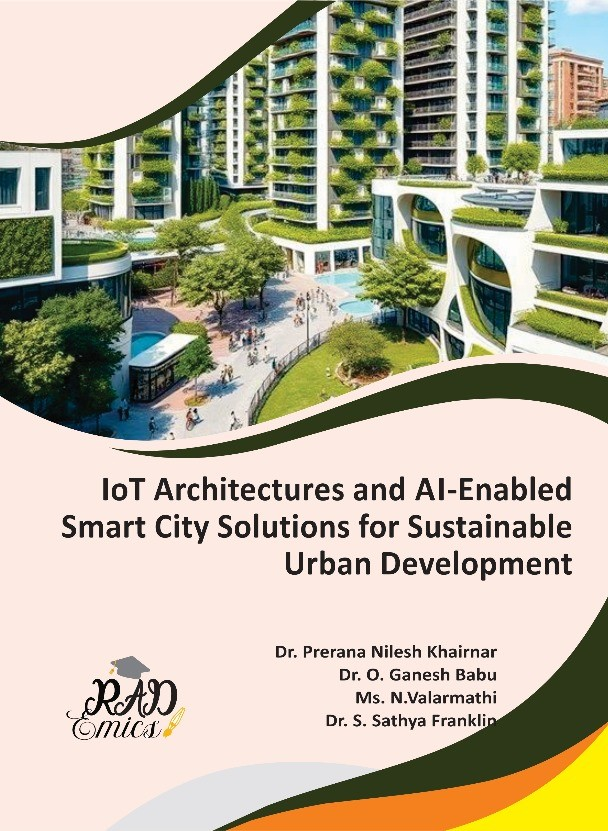
Peer Reviewed Chapter
Chapter Name : Predictive Analytics Using AI for Smart Policing Crime Prevention and Public Safety Management in Urban Areas
Author Name : Ramakrishna Hegde, Soumyasri S M, Jayanthi Boopathiramalingam
Copyright: ©2025 | Pages: 39
DOI: 10.71443/9789349552241-12
Received: 03/01/2025 Accepted: 09/03/2025 Published: 24/04/2025
Abstract
The integration of Artificial Intelligence (AI) and the Internet of Things (IoT) into smart policing frameworks is revolutionizing crime prevention and public safety management in urban areas. This book chapter explores the transformative potential of AI and IoT in enhancing law enforcement capabilities through predictive analytics, real-time surveillance, and automated decision-making systems. By examining the convergence of cutting-edge technologies, this chapter presents a comprehensive analysis of their role in improving public safety, optimizing resource allocation, and fostering inter-jurisdictional collaboration. However, the deployment of these technologies also introduces critical ethical and social challenges, including privacy concerns, bias in AI algorithms, and the balance between surveillance and civil liberties. The chapter further discusses the importance of data integration, cross-jurisdictional collaboration, and regulatory frameworks in ensuring that smart policing initiatives are both effective and equitable. With the increasing reliance on IoT sensors, AI-driven algorithms, and real-time data management systems, this work provides a forward-looking perspective on how smart policing technologies can shape the future of urban law enforcement while addressing the pressing issues of security, ethics, and governance.
Introduction
The integration of Artificial Intelligence (AI) and the Internet of Things (IoT) has reshaped the landscape of urban policing, enabling law enforcement agencies to leverage advanced technologies for enhanced crime prevention and public safety management [1]. The concept of smart policing utilizes these innovations to transform traditional policing methods into data-driven, proactive, and responsive systems [2]. AI, with its predictive capabilities, and IoT, with its interconnected sensors and devices, allow law enforcement to monitor, analyze, and respond to criminal activities in real-time [3]. This shift from reactive to proactive policing provides significant improvements in crime prevention, resource allocation, and the overall efficiency of law enforcement operations [4]. As urban areas become more complex, the need for such intelligent systems has become critical in ensuring public safety and addressing the challenges posed by rapidly evolving crime patterns [5].
One of the core advantages of AI and IoT in smart policing is their ability to provide real-time insights through the continuous collection and analysis of data from various sources [6]. IoT devices, such as surveillance cameras, sensors, and wearable technologies, create a vast network of interconnected devices that feed valuable data into AI algorithms [7]. These algorithms analyze patterns, predict potential threats, and help law enforcement agencies make informed decisions quickly [8]. AI-driven predictive analytics can forecast crime hotspots, identify emerging trends, and enable law enforcement to allocate resources more effectively [9]. This ability to anticipate and prevent crimes before they occur marks a significant evolution in urban policing, providing a level of precision and foresight that was previously unimaginable [10].
As the capabilities of AI and IoT continue to expand, so do the challenges associated with their implementation in law enforcement [11]. Privacy concerns, the security of collected data, and the risk of surveillance overreach are critical issues that need to be addressed [12]. As smart policing systems rely heavily on data collection from both public and private spaces, questions surrounding individual privacy and the ethical use of surveillance technologies have come to the forefront [13]. The potential for AI systems to perpetuate biases in decision-making, especially in criminal profiling, also poses significant ethical challenges [14]. As law enforcement agencies increasingly rely on these technologies, it becomes essential to establish safeguards that protect civil liberties while ensuring the technologies are used in ways that enhance public safety without infringing on fundamental rights [15].
The effectiveness of smart policing is contingent on the seamless integration and management of data from multiple sources. Law enforcement agencies often operate across different jurisdictions, each with its own set of data and technological systems [16]. The lack of uniformity in data sharing and integration can create barriers to effective collaborationn and hinder the overall success of smart policing initiatives [17]. To address this, urban law enforcement agencies must prioritize cross-jurisdictional collaboration, enabling the sharing of real-time data between different departments and stakeholders. This integration can provide a holistic view of criminal activity, allowing for more coordinated and comprehensive responses to public safety challenges . Effective data management and collaboration are essential for maximizing the potential of AI and IoT in transforming urban policing [18].